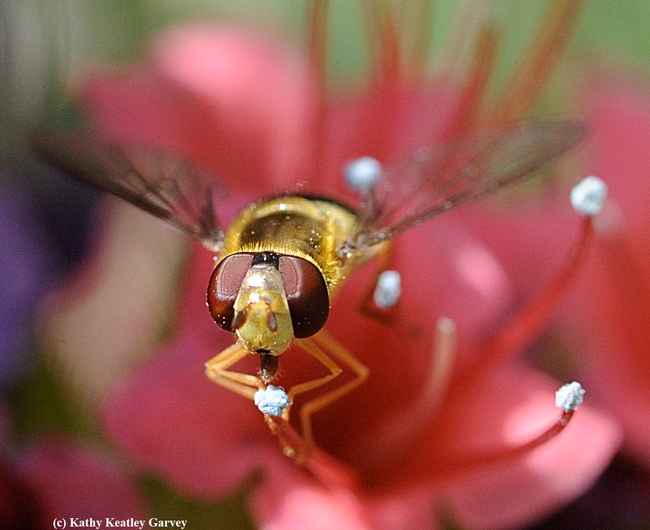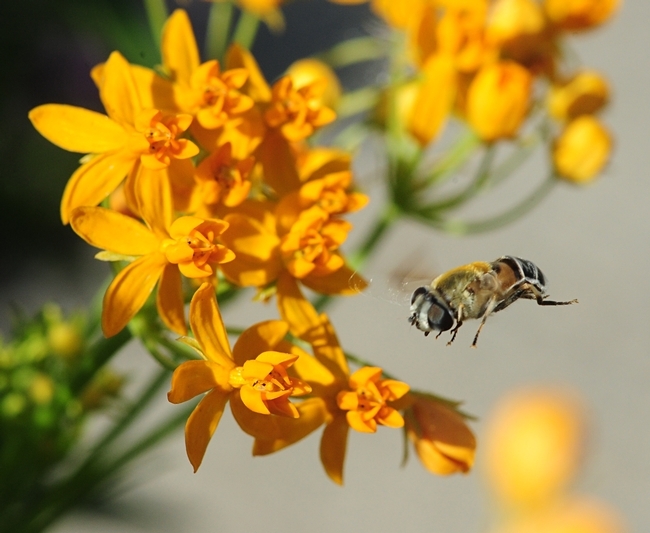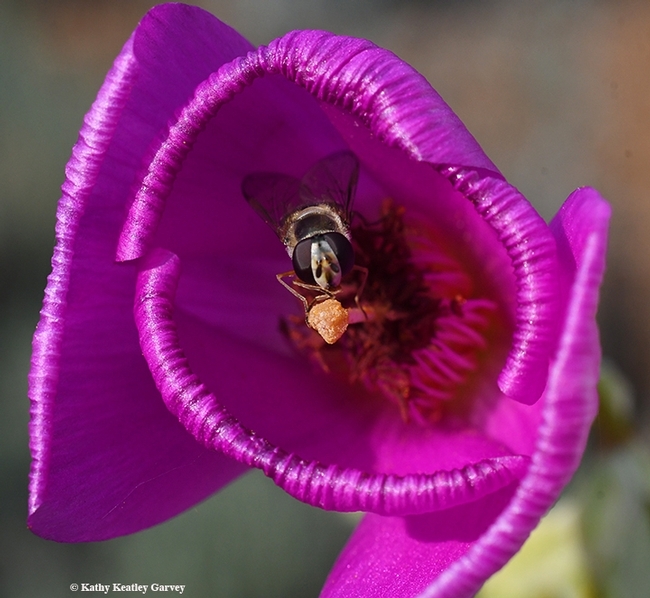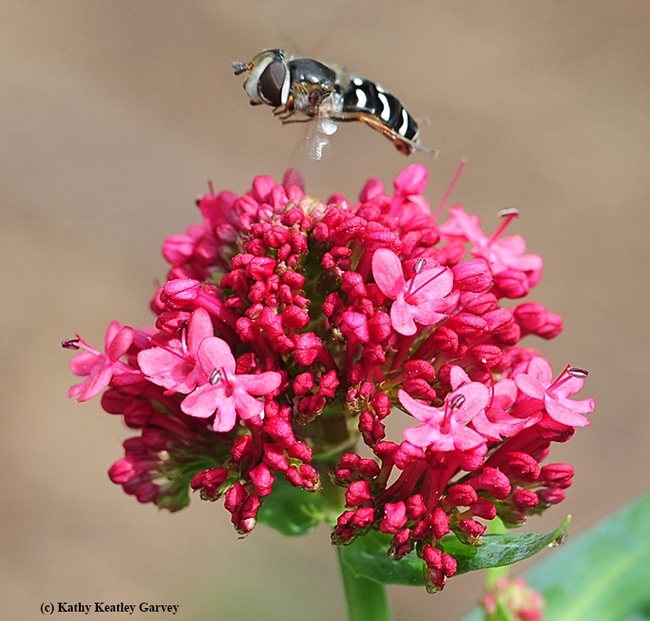- Author: Kathy Keatley Garvey
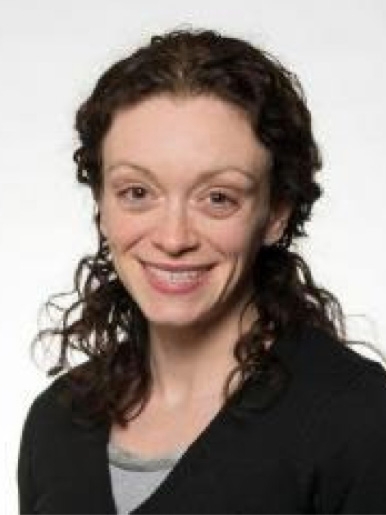
ACP they call it. A native of southern Asia, it was first detected it in the United States (Florida) in 1998.
ACP serves as a vector or carrier for the deadly citrus greening disease or Huanglongbing (HLB), a bacterial disease that infects and kills citrus trees.
"ACP arrived in Southern California in 2008 and has fully infested that region," according to the UC Statewide Integrated Pest Management Program. "HLB disease was first detected in Los Angeles in 2012."
You may remember when the equivalent of a five-alarm fire went off when the citrus greening disease was found in California. The California Department of Food and Agriculture (CDFA) sounded the alarm.
What's new in the research?
Research molecular biologist Michelle Heck of the USDA's Agricultural Research Service (USDA-ARS) in Ithaca, N.Y., will discuss "Challenge-Driven Innovation in Citrus Greening Disease Research" when she presents a virtual seminar hosted by the UC Davis Department of Entomology and Nematology at 4:10 p.m., Pacific Time, Wednesday, Feb. 16.
The seminar is open to all interested persons. The Zoom link is https://ucdavis.zoom.us/j/99515291076.
Heck, who focuses her USDA-ARS research on the discovery and characterization of insect vector-plant-pathogen interactions, serves as a lead scientist and research molecular biologist with the Emerging Pests and Pathogens Research Unit, located in the Robert W. Holley Center for Agriculture and Health, Ithaca.
The Asian citrus psyllid is a threat to America's citrus industry, according to a USDA Fact Sheet. "Burned tips and twisted leaves result from an infestation on new growth. Psyllids are also carriers of the bacterium that causes Huanglongbing (HLB) disease, also known as citrus greening disease, spreading the disease to healthy citrus plants. Citrus greening is one of the most serious citrus plant diseases in the world. Once a tree is infected, there is no cure."
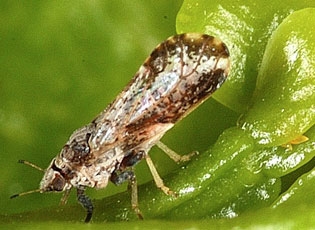
"Research planning involves novel, exceptionally difficult, team research that is subdivided into multiple phases with agency stakeholders," Heck says. Her research "integrates developed knowledge into applied agricultural practices to create novel management strategies for vector-borne plant diseases and the insect vectors." She conducts her studies in support of the USDA-ARS NP 304 Action Plan: Crop Protection and Quarantine, Problem Statement 3A2, a systems approach to environmentally sound pest management.
Heck, who holds a bachelor's degree in biology from Boston University, received her doctorate from.Cold Spring Harbor Laboratory, Cold Spring, N.Y. She completed her postdoctoral training in vector biology and mass spectrometry-based proteomics. Her research on protein interactions and protein transport in plants and insects spans more than 20 years, resulting in an international reputation as a vector biology authority skilled in the management of vector-borne plant diseases. Heck is a lead in the USDA-ARS Citrus Greening Grand Challenge, the agency's coordinated national response to combat citrus greening disease and the agency's scientific representative on the National Cotton Council's Cotton Leafroll Dwarf Virus Task Force.
Heck has published more than 50 peer-reviewed journal articles, book chapters, and several patents. Her peers have recognized her scientific excellence with a number of awards, including a 2017 Presidential Early Career Award for Scientists and Engineers from the Obama White House Office of Science and Technology Policy.
For technical issues involving the seminar, contact Siddique at siddique@ucdavis.edu.
Resources:
- Asian Citrus Psyllid, UC Statewide Integrated Pest Management Program (UC IPM)
- Asian Citrus Psyllid and Huanglongbing Disease (UC IPM)
- Asian Citrus Psyllid Regulation and Quarantine Boundaries, California Department of Food and Agriculture (CDFA)
- Citrus Pest and Disease Prevention, CDFA
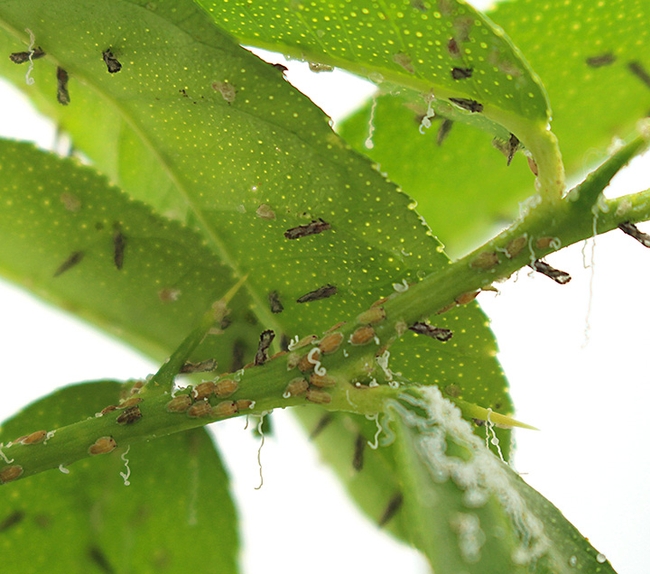
- Author: Kathy Keatley Garvey

Renowned wasp expert Marius Wasbauer (1928-2021) studied them for about six decades. When he died this spring in Brookings, Ore., his family donated his collection of specimens to the UC Davis Bohart Museum of Entomology.
It's a massive collection of more than 50,000 aculeate (stinging) wasp specimens, primarily spider wasps.
Wasbauer, a retired senior scientist/systematist at the California Department of Food and Agriculture, in a career spanning 34 years, was a global expert on spider wasps and a scientific collaborator with Lynn Kimsey, director of the Bohart Museum and a UC Davis distinguished professor of entomology. He was a member of the Bohart Museum Society and a strong supporter of the museum.
Spider wasps, also known as spider-hunting wasps or pompilid wasps, belong to the family Pompilidae. The worldwide family is comprised of some 5,000 described species in six subfamilies.
“A U-Haul was needed to transport the collection from Brookings to Davis last weekend,” Kimsey said. “The donation consists of a diversity of aculeate wasps but 95 percent are spider wasps (Pompilidae), an estimated 50,000 specimens from all over the world, in 180 drawers, in 13 24-drawer cabinets,” Kimsey said. “This is material he had been accumulating since the 1960s.”
Wasbauer studied entomology and biosystematics at UC Berkeley, where he received his bachelor's degree and doctorate (1958). “Like many entomologists of his generations,” Kimsey said, “Marius was an instructor in preventive medicine in the U.S. 7th Army Medical Service at Fort Sam Houston, Texas.” He joined the California Department of Food and Agriculture (CDFA) as a systematist in September 1958.
“He published nearly 50 papers in wasp taxonomy and the biology of a diversity of insects,” Kimsey noted. “His taxonomic research focused on several groups of aculeate wasps, including Pomplidae, nocturnal Tiphiidae and myromosid wasps. Other studies included walnut serpentine leaf miners, tephritid fruit flies, bumble bees and even crane flies.”
Wasbauer was a fellow of the California Academy of Sciences; president and secretary of the Pacific Coast Entomological Society; research associate with the U.S. Department of Agriculture's Agricultural Research Service (USDA-ARS), a member of Sigma Xi, the scientific research honor society; a member of the Biosystematists Society; and a research associate at UC Davis.
“He was generous with his time, and worked with many scientists and students around the world,” Kimsey said. “However, aside from his family and wasps, his other greatest love was fishing.”
Marius and his wife, Joanne, longtime supporters of the Bohart Museum, frequently offered annual challenge grants of $5000, matching donations of other donors up to $5000. They hoped to inspire others to give.
The Wasbauers participated in a Bohart Museum Bioblitz to Belize in 2017, a trip led by entomologists David Wyatt, a professor at Sacramento City College, and Fran Keller, now a professor at Folsom Lake College. Keller, who holds a doctorate in entomology from UC Davis, is a Bohart Museum research associate.
A trio of entomologists—Lynn Kimsey and her husband, forensic entomologist Robert Kimsey of the Department of Entomology and Nematology; and Bohart Museum research associate Brennen Dyer—prepared a space in the Bohart for the large donation. They unloaded the truck with Kimsey friends, retired Placer County Sheriff Mike Whitney and his wife, Becky.
The Bohart Museum, which is celebrating its 75th anniversary this year, houses a global collection of nearly eight million insect specimens, plus a live “petting zoo” comprised of Madagascar hissing cockroaches, walking sticks and tarantulas. The Bohart Museum also inclues a year-around gift shop stocked with insect-themed t-shirts, sweatshirts, posters, books, jewelry and insect-collecting equipment.
Temporarily closed due to COVID-19 pandemic precautions, the Bohart is located in Room 1124 of the Academic Surge Building on Crocker Lane.
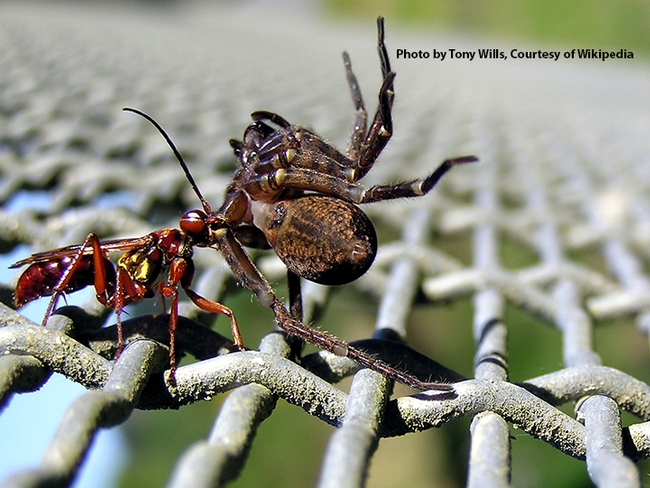
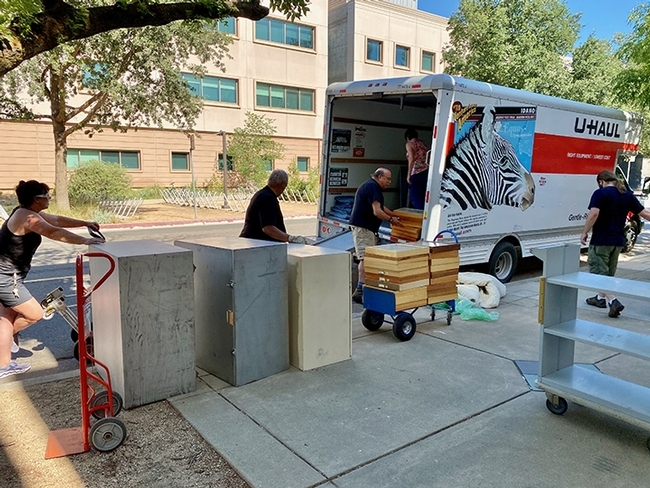
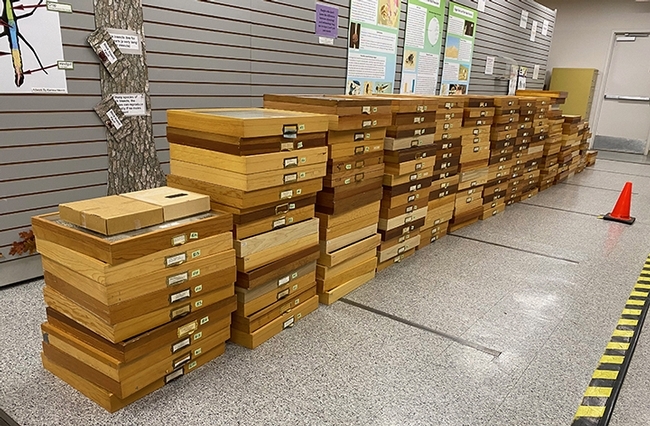
- Author: Kathy Keatley Garvey
It's not often you see a Mexican cactus fly, Copestylum mexicanum, nectaring on a Mexican sunflower, Tithonia rotundifolia.
At first glance, you may think the insect is a carpenter bee or bumble bee.
Then you see it hovering. Then you see its head. Then you see its stubby antennae.
Fly!
It's a large black syrphid fly, aka flower fly or hover fly.
The genus Copestylum includes more than 350 species in the new world, according to Martin Hauser, senior insect biosystematist with the Plant Pest Diagnostics Branch of the California Department of Food and Agriculture (CDFA).
Lynn Kimsey, director of the Bohart Museum of Entomology and UC Davis professor of entomology, says the female Mexican cactus fly lays its eggs in rotting or dying cactus tissue.
This fly, about 3/4 of an inch long, was a few inches short of a neighboring cactus, a torch cactus, Echinopsis spachiana.
The cactus is neither dying nor rotten.
Thankfully.
The Mexican cactus fly simply stopped to sip some nectar from the Mexican sunflower.
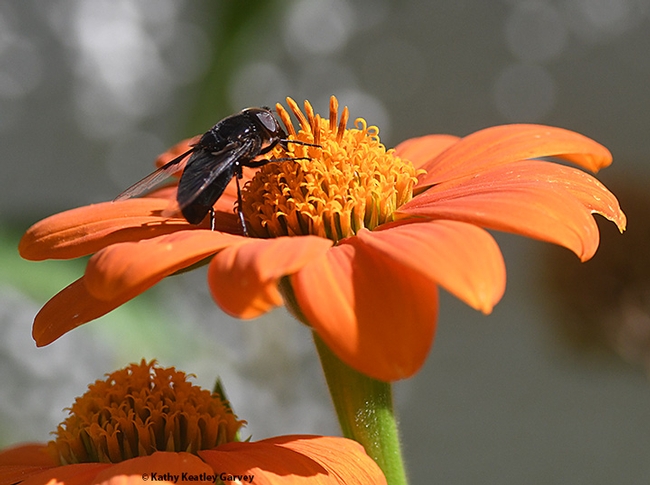
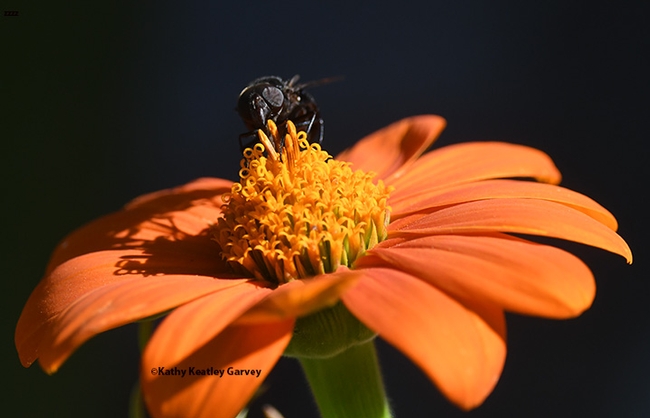
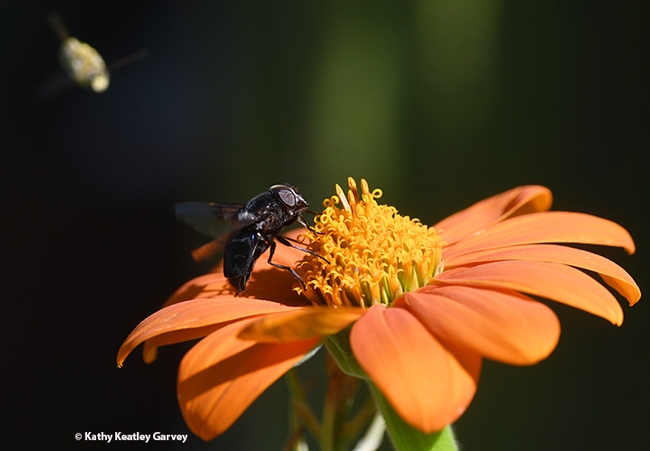
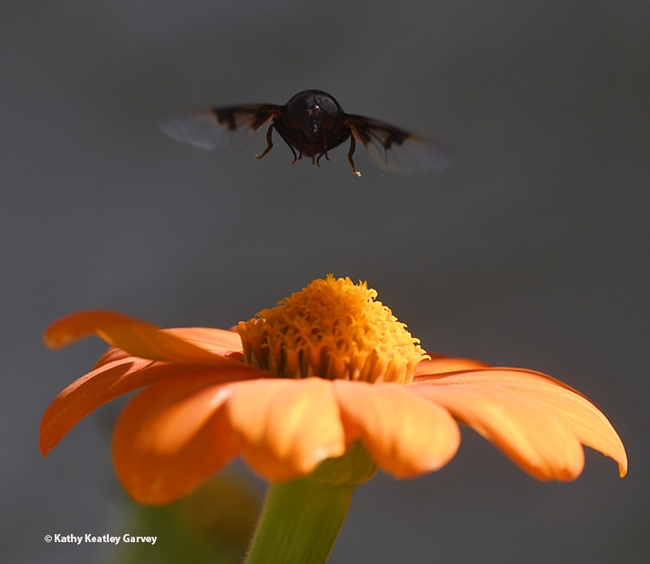
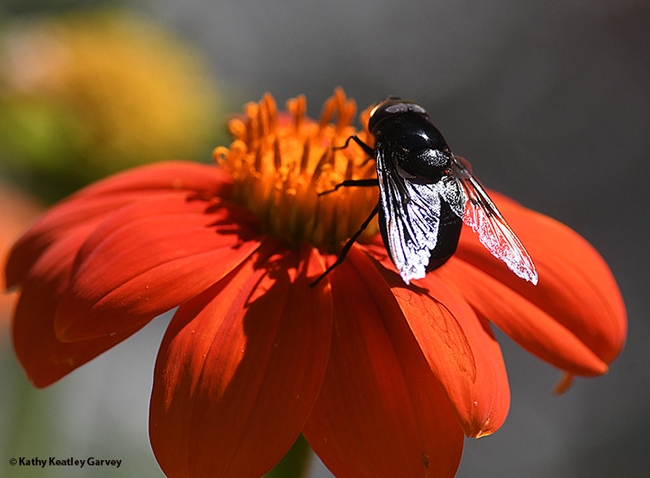
- Author: Kathy Keatley Garvey
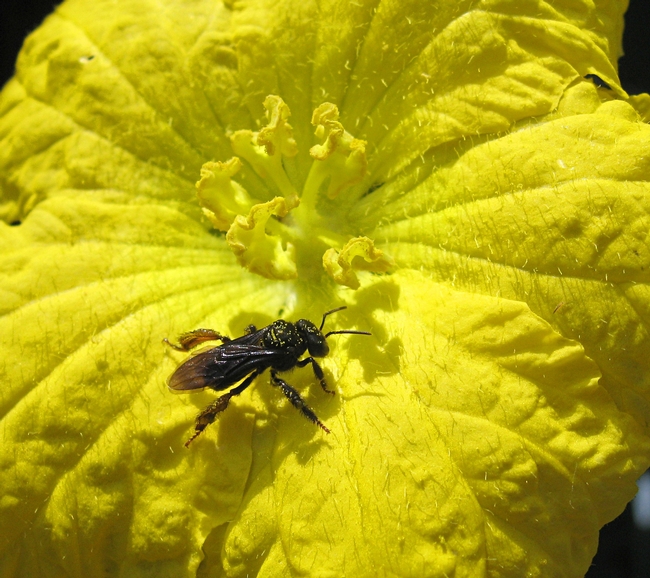
Isn't it illegal to import stingless bees in the United States? It is.
So what's going on?
Members of the Pacific Coast Entomological Society and guests will find out when Martin Hauser, senior insect biosystematist with the Plant Pest Diagnostics Center, California Department of Food and Agriculture (CDFA), speaks on “The Curious Case of the Stingless Bees of Palo Alto” on Thursday night, Feb. 27 on the UC Davis campus.
The society will meet at 7:30 p.m. in the conference room of the Museum of Wildlife and Fish Biology, Room 1371 of the Academic Surge Building on Crocker Lane.
“In 2013 we found a stingless bee colony in Palo Alto in a tree,” Hauser said, “and I had a very hard time identifying the species—the genus is Plebeia—and I had no idea how they made it into California and where they came from. Many years later and many strange events later, I figured all these things out.”
Hauser will discuss his research and also reveal how long stingless bees have been recorded in California.
The 7:30 p.m. meeting begins with a general business session, followed by Hauser's talk.
A pre-meeting dinner will begin at 6 p.m. at the KetMoRee restaurant in downtown Davis. Members and entomology associates interested in joining the group for dinner should e-mail Catherine "Kady" Tauber at cat6@cornell.edu before Tuesday, Feb. 25.
The society meets six to eight times a year, usually at the California Academy of Sciences, UC Berkeley, or at the CDFA's Plant Pest Diagnostics Center. Membership in the society, organized in 1901, is open to everyone--amateurs and professionals alike. The annual membership fee is $25, and $12.50 for students. The society publishes the quarterly journal, The Pan-Pacific Entomologist. and the Bits and PES Newsletter for members residing within commuting distance of San Francisco.
Contacts: Kandis Gilmore (kandis.gilmore@gmail.com) or Kady Tauber (cat6@cornell.edu).
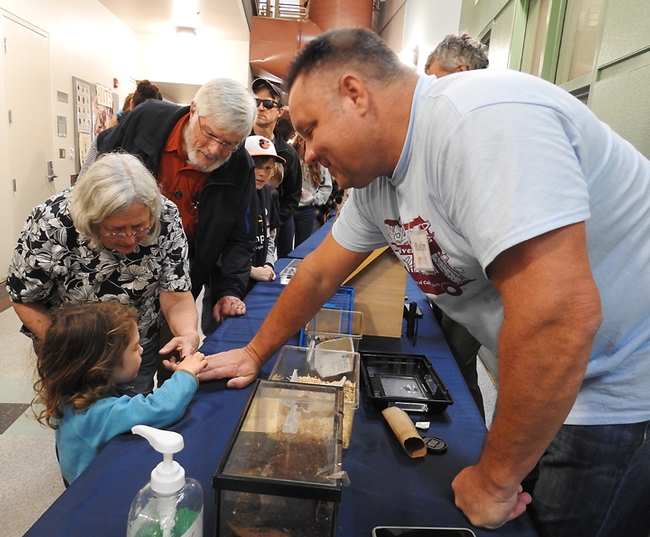
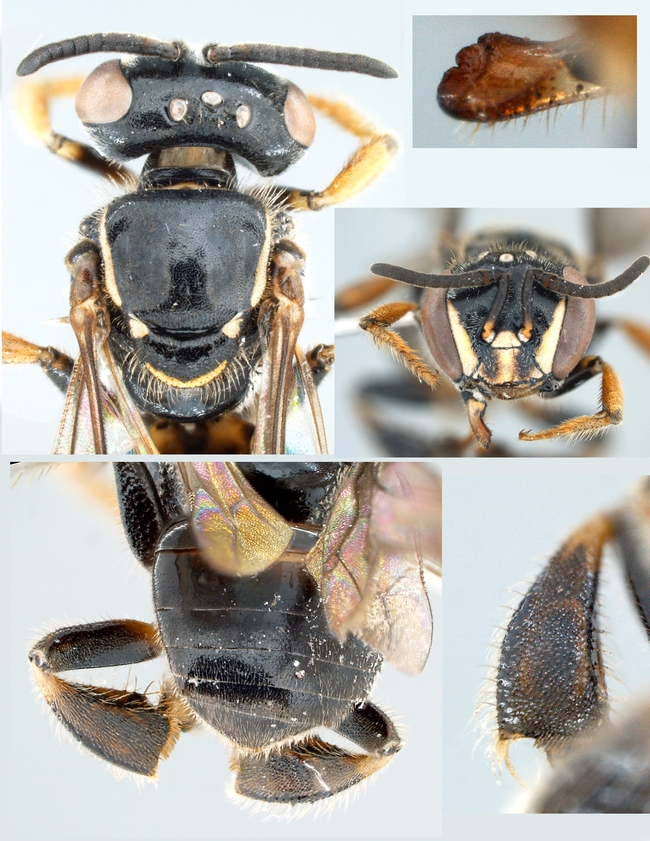
- Author: Kathy Keatley Garvey
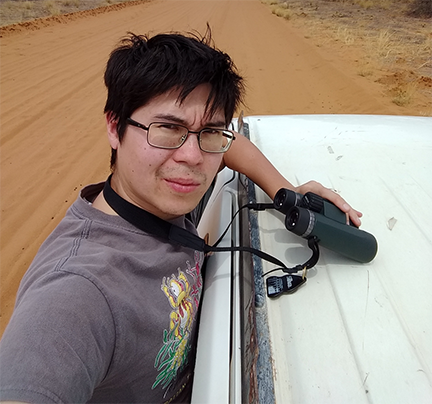
You've probably seen them hovering over flowers, which is why syprhids are commonly called "hover flies" or "flower flies."
Enter Andrew Young.
He's a UC Davis postdoctoral researcher with the Department of California Food and Agriculture (CDFA) and he researches syrphids.
Young, who specializes in Diptera taxonomy and phylogenetics at CDFA, will present a seminar to the UC Davis Department of Entomology and Nematology on "The Natural History of Syrphidae: from Pollinators to Parasitoids" at 4:10 p.m., Wednesday, Feb. 5 in 122 Briggs Hall, off Kleiber Hall Drive.
"Syrphidae (Dlptera) is a species-rich family of true fly, with over 6200 described species worldwide," he says in his abstract. "Often known as flower flies or hover flies, syrphlds are likely the most significant group of pollinators outside of the bees--especially in Arctic climates. While research into their pollination-related behavior is still nascent, other aspects of flower fly biology have been relatively well-studied."
"Adults of many species are well-known for their impressive mimicry of stinging Hymenoptera, and known larvae display a degree of habitat diversity that is unusually broad for a single family of Diptera. Many larvae are predators on soft-bodied insects such as aphids, and therefore, show potential for crop-pest management, while others are aquatic filter-feeders that may have value in waste-management applications." (See UC Integrated Pest Management Program website on syrphids; in their larval stage, they feed on aphids.)
Young says he will give an overview of the current understanding of flower fly phylogeny, followed by an exploration of the varied many adult and larval natural histories known to the group. He will emphasize "many of the little-known larval life histories that are still actively being discovered by dedicated field researchers. I will conclude by briefly discussing some of my past, present and future flower fly research."
Young studied Syrphidae in the lab of Stephen Marshall, professor of entomology at the University of Guelph, Ontario, Canada. Marshall and Young are among the six co-authors of Field Guide to the Flower Flies of Northeastern North America" (Princeton University Press, 2019), a book described as "a groundbreaking guide to flower flies in North America."
From the Princeton University Press website: "Flower flies are, along with bees, our most important pollinators. Found in a varied range of habitats, from backyard gardens to aquatic ecosystems, these flies are often overlooked because many of their species mimic bees or wasps. Despite this, many species are distinctive and even subtly differentiated species can be accurately identified." The guide includes more than 3,000 color photographs and 400 maps, covering all 416 species of flower flies that occur north of Tennessee and east of the Dakotas, including the high Arctic and Greenland. Each species account provides information on size, identification, abundance, and flight time, along with notes on behavior, classification, hybridization, habitats, larvae, and more."
Lynn Kimsey, director of the Bohart Museum of Entomology and professor of entomology at UC Davis, is the seminar host. Community ecologist Rachel Vannette, assistant professor, coordinates the weekly seminars.
Upcoming seminars for the winter quarter (See speaker list) are at 4:10 p.m. on Wednesday in 122 Briggs Hall.
Wednesday, Feb. 12
Kevin Rice, University of Missouri, Columbia
Topic: "Lasers, Drones, and Growth Promoting Fungus: New Technologies for IPM"
Host: Ian Grettenberger, assistant professor
Wednesday, Feb. 19
Mercedes Burns, University of Maryland,>Baltimore County
Topic: (pending) She studies evolutionary ecology of reproductive traits and behaviors, sexual conflict, reproductive polymorphism, arthropod biology
Host: Jason Bond, professor and Schlinger Chair in Insect Systematics
Wednesday, Feb. 26:
Faculty Flash Talks (featuring faculty members Rachel Vannette, Ian Grettenberger, Shahid Siddique, Geoffrey Attardo, Jason Bond)
Wednesday, March 4
Brendon Boudinot, doctoral candidate, Phil Ward lab, exit seminar
Topic: "Morphology and Evolution of the Insects, and the Ancestors of the Ants"
Host: Phil Ward, professor
